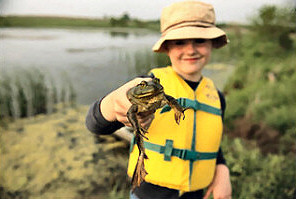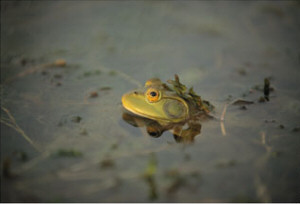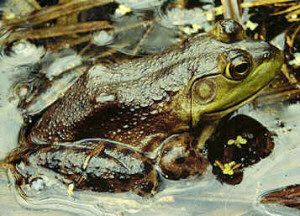
HOME
INTRO
SYMBOLS
ALMANAC
ECONOMY
GEOGRAPHY
STATE MAPS
PEOPLE
GOVERNMENT
FORUM
NEWS
COOL SCHOOLS
STATE QUIZ
STATE LINKS
BOOK STORE
MARKETPLACE
GUESTBOOK
CONTACT US


Tweet
Double click on word for definition.
Oklahoma State Amphibian

Big Bullfrog and Small Boy Print
With help from Brushy School (Sallisaw, OK) teacher Pat Grabe and his seventh-grade students, Oklahoma became the sixth state to adopt an official state amphibian following New Hampshire, Arizona, Louisiana, Kansas and Tennessee.
The main reasons for adoption of the Bullfrog as the official amphibian of Oklahoma seem to revolve around its significant presence throughout the state, its general character and its role in the ecology of the state.
As summed up in House Concurrent Resolution No. 1026, the "...versatile and prolific bullfrog is an integral part of the ecology of Oklahoma and generally represents the importance of all species of amphibians to the environment and our state."
ENROLLED HOUSE
CONCURRENT
RESOLUTION NO. 1026By: Stites of the House
and Shurden of the SenateA Concurrent Resolution declaring the bullfrog, "Rana catesbeiana", as the state amphibian for the State of Oklahoma; and directing distribution.
WHEREAS, the bullfrog, "Rana catesbeiana", is the largest frog in North America, ranging from Nova Scotia to central Florida and from Wisconsin west across the great plains to the Rockies and is also found throughout Oklahoma; and
WHEREAS, the coloring of the bullfrog can vary from a plain green to a green background with a netlike pattern of gray or brown on the dorsal or top portion of the frog; and
WHEREAS, while the bullfrog prefers larger, deeper bodies of water, it can be found in almost every lake, pond, bog, sluggish portions of a stream and even cattle tanks; and
WHEREAS, the bullfrog can usually be seen at the water's edge, amidst vegetation or among snags in which it can hide; and
WHEREAS, the voice of the male bullfrog, which is used for breeding purposes to attract females, is a vibrant scenarist series of bass notes, with a distinctive sound best described as "jug-o-rum"; and
WHEREAS, the bullfrog is found statewide all year round, being active from March to September and inactive during the winter months, when it apparently burrows in the mud beneath the water; and
WHEREAS, the bullfrog is an opportunistic predator, eating anything that it can swallow, including beetles, small turtles, snakes, birds and crayfish; and
WHEREAS, the versatile and prolific bullfrog is an integral part of the ecology of Oklahoma and generally represents the importance of all species of amphibians to the environment and our state.
NOW, THEREFORE, BE IT RESOLVED BY THE HOUSE OF REPRESENTATIVES OF THE 1ST SESSION OF THE 46TH OKLAHOMA LEGISLATURE, THE SENATE CONCURRING THEREIN:
THAT the bullfrog, "Rana catesbeiana", be recognized as the state amphibian of the State of Oklahoma.
THAT copies of this resolution be distributed to the Director of the Department of Wildlife Conservation; Dr. John Turner, Superintendent of Brushy Dependent School District; Darlus Edwards, Assistant Principal of Brushy Dependent School District; Pat Grabe, Seventh Grade Teacher at Brushy Dependent School District; and to the students of the Seventh Grade Class of Brushy Dependent School District.
Adopted by the House of Representatives the 5th day of May, 1997.
Speaker of the House of RepresentativesAdopted by the Senate the 5th day of May, 1997.
President of the Senate

Bullfrog is Watching Print
House Concurrent Resolution No. 1026 designating the Bullfrog (Rana catesbeiana) as "the state amphibian of the State of Oklahoma" was adopted by the Oklahoma House of Representatives and the Oklahoma Senate on May 5, 1997. A copy of the resolution was filed with the Oklahoma Secretary of State on May 6, 1997.
Copies of the resolution were distributed to the Director of the Oklahoma Department of Wildlife Conservation, to Brushy School District Superintendent Dr. John Turner, to Assistant Principal Darlus Edwards, to seventh-grade teacher Pat Grabe and to the students of the seventh-grade class.
About the Bullfrog

Photograph: © Dr. James Bogart. Used with permission.
Bullfrogs are the big guys in the land of frogs and toads in North America. They can grow to be 3 1/2 to 8 inches long and weigh up to PP pounds. They are generally colored in shades of green or brownish and often display darker colors on their backs. On average, Bullfrogs live from seven to nine years.
Bullfrogs require water and like to live in warm, shallow waters of wetlands, ponds, lakes or rivers. They prefer warm waters and hibernate in cold weather. They create small caves in mud that serve as home in the winter.
The call of male Bullfrogs is deep and a rather loud and can travel over a 1/4 mile. The sound is described as a low rumbling "jug-o-rum". Not only are Bullfrogs big and loud, they are quite protective of their staked out territories and will aggressively defend them, by physical wrestling, from trespassers.
When they are not actively defending their territory or looking for mates, they can usually be found sitting and waiting for something good to eat to come their way. They hunt for their dinner by waiting until it passes by. Then, when a tasty snake or insect comes within range, they lunge and grab their prey with a quick, lashing tongue. They are always hungry and will eat almost anything that comes their way. They'll eat snakes, crayfish, worms, insects, turtles, lizards, fishes, birds, shrews, moles, other frogs and tadpoles. They've even been reported to dine on bats.
Oklahoma Law
Because the Bullfrog was adopted by concurrent resolution, the signature of the governor was not required and the bullfrog is not listed in the Oklahoma Statutes.
Sources...
Oklahoma Legislature. 2005. 3 January 2005 .
Oklahoma Department of Libraries. 2005. 10 January 2005
Georgia Museum of Natural History. 2005. 12 January 2009
Shearer, Benjamin F. and Barbara S. State Names, Seals, Flags and Symbols: A Historical Guide Third Edition, Revised and Expanded. Westport, Conn: Greenwood Press, 3 Sub edition, 2001.
Additional Information
American Bullfrog: Oklahoma Department of Wildlife Conservation.
American Bullfrog Rana catesbeiana: National Geographic: Animals.
Rana catesbeiana Bullfrog, American Bullfrog: University of California, Berkley; AmphibiaWeb.
Rana catesbeiana (North American bullfrog): University of Michigan Museum of Zoology: Animal Diversity Web.
American Bullfrog Lithobates catesbeianus: The Encyclopedia of Life.
Rana catesbeiana - Shaw, 1802 - Bullfrog: NatureServe Explorer.
Rana catesbeiana Shaw, 1802: Integrated Taxonomic Information System (ITIS) Here you will find authoritative taxonomic information on plants, animals, fungi, and microbes of North America and the world.
State amphibians: Complete list of official state amphibians from NETSTATE.COM.
More symbols & emblems: Complete list of official Oklahoma state symbols from NETSTATE.COM.
![]() Frog and Toad Posters and Prints: Frog and toad posters and prints from AllPosters.com.
Frog and Toad Posters and Prints: Frog and toad posters and prints from AllPosters.com.
What is an Amphibian? (The Science of Living Things) , by Bobbie Kalman and Jacqueline Langille, 32 pages, Crabtree Publishing Company (2000). Reading level: Ages 9-12. The large, full-color photographs and illustrations that pepper every page of these books will catch the eye of browsers but it is the informative, easy-to-read texts that will hold their interest.
Peterson First Guide to Reptiles and Amphibians , by Robert C. Stebbins, Joseph T. Collins and Roger Conant. Edited by Roger Tory Peterson. 128 pages, Houghton Mifflin Harcourt (April 15, 1999). From mudpuppies to rattlesnakes, this fascinating guide for young nature lovers describes the habits and habitats of these secretive and sometimes bizarre animals, and includes tips on how to catch and care for frogs, snakes, turtles, lizards, salamanders, and toads.
A Field Guide to Reptiles & Amphibians of Eastern & Central North America, by Roger Conant and Joseph T. Collins, 640 pages, Houghton Mifflin Harcourt; Fourth Edition edition (May 15, 1998). This newly designed field guides features detailed descriptions of 595 species and subspecies. The 656 full-color illustrations and 384 drawings show key details for accurate identification. More than 100 color photographs and 333 color photographs and 333 color distribution maps accompany the species descriptions.
Firefly Encyclopedia of Reptiles and Amphibians, edited by Tim Halliday and Kraig Adler, 240 pages, Firefly Books (September 7, 2002). With lush color photographs and lavishly detailed illustrations, this encyclopedia presents a striking abundance of information at a glance. Also noteworthy is the scholarly text, a comprehensive overview of these frequently studied phyla.
Care and Breeding of Popular Treefrogs: A Practical Manual for the Serious Hobbyist, by Philippe de Vosjoli, Robert Mailloux, Drew Ready. 205 pages, Advanced Vivarium Systems (January 1, 1997) This book is written by experienced and recognized frog herpetoculturists and focuses on the care of popular tree frogs now sold in significant numbers. It covers many important topics that are required knowledge for successful keeping. Acclimating imported species, housing, feeding and captive breeding are included. A practical manual for the serious hobbyist.
Frogs, Toads, and Treefrogs: Everything About Selection, Care, Nutrition, Breeding, and Behavior, by R. D. Bartlett and Patricia P. Bartlett. 104 pages. Barron's Educational Series (February 1, 1996) This manual includes detailed instructions for maintaining a proper terrarium, taking preventative measures against parasites and disease, ensuring a healthful diet for your amphibians, profiles of popular species, and more.
Reptiles & Amphibians for Dummies, by Patricia Bartlett, 360 pages, For Dummies; 1st edition (June 1, 2003) This essential guide tells you what you must know before you own a reptile or amphibian, with authoritative advice on everything from proper caging and feeding to health care, socializing, transporting, and more. You'll find out about the different species, normal and abnormal behavior, the basics of breeding, and complying with laws.

